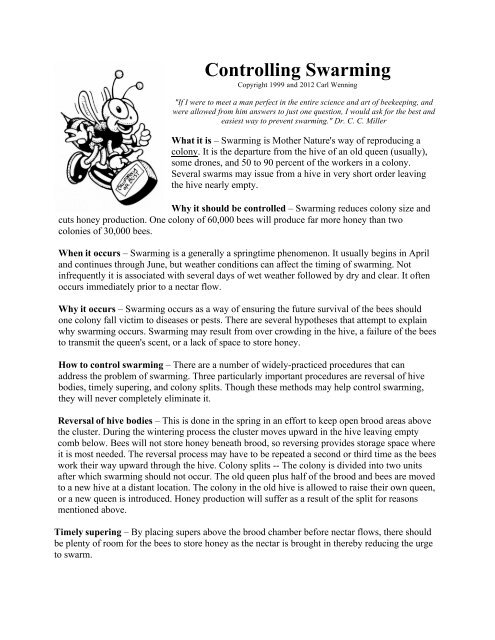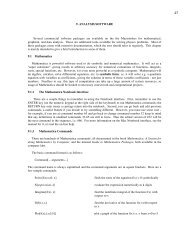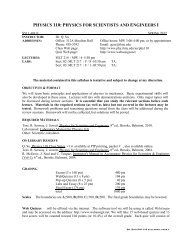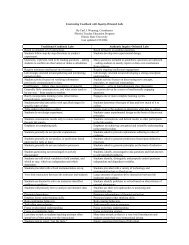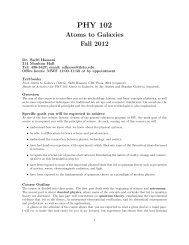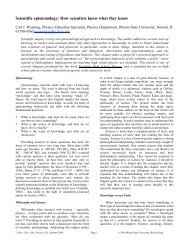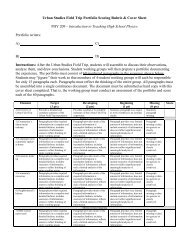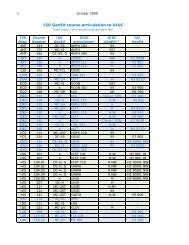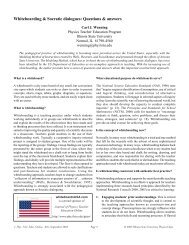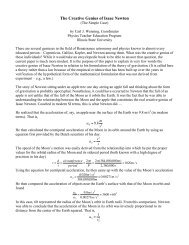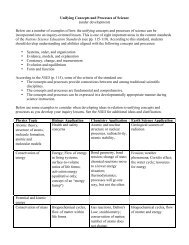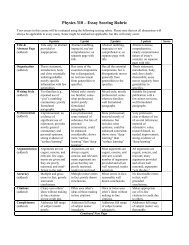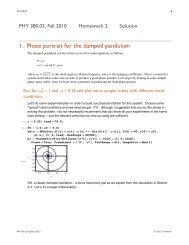Controlling Swarming
Controlling Swarming
Controlling Swarming
You also want an ePaper? Increase the reach of your titles
YUMPU automatically turns print PDFs into web optimized ePapers that Google loves.
<strong>Controlling</strong> <strong>Swarming</strong><br />
Copyright 1999 and 2012 Carl Wenning<br />
"If I were to meet a man perfect in the entire science and art of beekeeping, and<br />
were allowed from him answers to just one question, I would ask for the best and<br />
easiest way to prevent swarming." Dr. C. C. Miller<br />
What it is – <strong>Swarming</strong> is Mother Nature's way of reproducing a<br />
colony. It is the departure from the hive of an old queen (usually),<br />
some drones, and 50 to 90 percent of the workers in a colony.<br />
Several swarms may issue from a hive in very short order leaving<br />
the hive nearly empty.<br />
Why it should be controlled – <strong>Swarming</strong> reduces colony size and<br />
cuts honey production. One colony of 60,000 bees will produce far more honey than two<br />
colonies of 30,000 bees.<br />
When it occurs – <strong>Swarming</strong> is a generally a springtime phenomenon. It usually begins in April<br />
and continues through June, but weather conditions can affect the timing of swarming. Not<br />
infrequently it is associated with several days of wet weather followed by dry and clear. It often<br />
occurs immediately prior to a nectar flow.<br />
Why it occurs – <strong>Swarming</strong> occurs as a way of ensuring the future survival of the bees should<br />
one colony fall victim to diseases or pests. There are several hypotheses that attempt to explain<br />
why swarming occurs. <strong>Swarming</strong> may result from over crowding in the hive, a failure of the bees<br />
to transmit the queen's scent, or a lack of space to store honey.<br />
How to control swarming – There are a number of widely-practiced procedures that can<br />
address the problem of swarming. Three particularly important procedures are reversal of hive<br />
bodies, timely supering, and colony splits. Though these methods may help control swarming,<br />
they will never completely eliminate it.<br />
Reversal of hive bodies – This is done in the spring in an effort to keep open brood areas above<br />
the cluster. During the wintering process the cluster moves upward in the hive leaving empty<br />
comb below. Bees will not store honey beneath brood, so reversing provides storage space where<br />
it is most needed. The reversal process may have to be repeated a second or third time as the bees<br />
work their way upward through the hive. Colony splits -- The colony is divided into two units<br />
after which swarming should not occur. The old queen plus half of the brood and bees are moved<br />
to a new hive at a distant location. The colony in the old hive is allowed to raise their own queen,<br />
or a new queen is introduced. Honey production will suffer as a result of the split for reasons<br />
mentioned above.<br />
Timely supering – By placing supers above the brood chamber before nectar flows, there should<br />
be plenty of room for the bees to store honey as the nectar is brought in thereby reducing the urge<br />
to swarm.
Other less labor-intense, but just as important, procedures for controlling swarming include working with<br />
queens and other general considerations:<br />
Keep young queens – Colonies with queens less than two years old are unlikely to swarm. Requeen<br />
every two years to reduce swarming and to ensure healthy, productive<br />
queens. A colony with a three-year-old queen is twice as likely to swarm as a colony with a two-year-old<br />
queen. There appears to be little difference between queens of one and<br />
two years.<br />
Keep productive queens – Queens that are failing to lay a sufficient number of eggs or produce<br />
enough of the pheromone known as queen substance are prone to supersedure. When the old queen is<br />
replaced through supersedure, swarming sometimes takes place.<br />
Act promptly when signs of swarming appear – When you see that a swarm is about to issue from<br />
the hive (appearance of multiple queen cells, crowded hive conditions, bees "hanging out" near the hive<br />
entrance), act promptly and decisively. The more drastic the means utilized, the more likely preventive<br />
measures will be successful.<br />
Treat causes rather than symptoms – Develop a good understanding of the swarming tendency, and<br />
avoid measures that merely treat symptoms and generally delay rather then prevent swarming.<br />
What won't work – Some practices supposedly used to prevent or remediate swarming, do little more<br />
than delay it. Among these practices are the following:<br />
clipping one of the queen's wings – This procedure is often used to mark new queens resulting in a<br />
queen that cannot fly. The new queen's left wing is clipped when acquired during odd-numbered<br />
years; the right wing when acquired in even-numbered years. This often provides a false sense of<br />
confidence due to the fact that the queen cannot fly away with an issuing swarm. When a colony<br />
swarms and a clipped queen is forced out of the hive, she cannot fly and generally cannot return.<br />
Such a queen is thereby lost. In this case, the swarm returns to the hive and leaves a few days later<br />
with a virgin queen. <strong>Swarming</strong> has been delayed, not prevented.<br />
removing queen cells – Cutting out queen cells can delay swarming, but does not reduce the<br />
swarming urge. The bees will work diligently to raise another queen until such time as they can do<br />
so successfully. Their efforts generally outlast those of the beekeeper and<br />
swarming occurs.<br />
returning a captured swarm to its hive – Unless the factors that caused the swarming to occur in<br />
the first place are corrected, returning a captured swarm to its hive will only be an invitation to<br />
further swarming.<br />
Benefits of swarming – As much as has been said about swarming that is negative, some good may yet<br />
occur. Capturing a swarm is a lot of fun and a great way to build up the number of colonies in your<br />
apiary. Swarms are usually quite gentle and are easy to work with. Because larger swarms usually<br />
contain an old queen that soon will be superseded, it is wise to requeen the colony after removing the<br />
old queen. Sometimes beekeepers are called upon to remove swarms from trees, bushes, and the eaves<br />
of houses. This can provide an additional source of income for the beekeeper.


